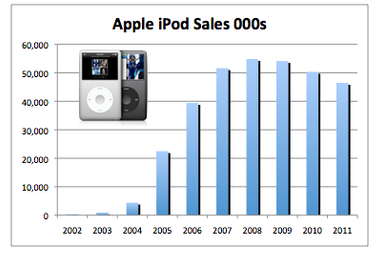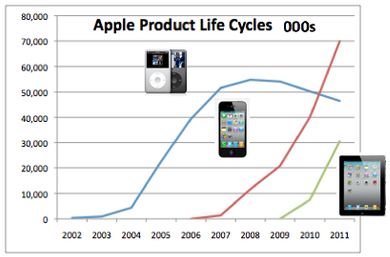Introduction
According to definition provided in the biology sciences, living things follow a rigid development lifecycle of birth, growth, maturity and death. This cycle forms the basis for the concept of product lifecycle and, by extension, a framework for describing the path a certain product will follow in a particular period of time.
In product management, this concept comprises of introduction, growth, maturity and decline stage. In the introduction stage, it takes some time for a product to be accepted by the public, but by the time it reaches the growth stage it is able to attract many customers. In maturity stage, its market even out as competitors develop competitive products, and its popularity declines. Old products are finally withdrawn from the market marking decline (Marketing Teacher, 2000, Para 1).
Since PLC depicts the product path from the launching period, it is a perfect tool for managing a product. Organizations can establish customer demands and alter the products features to meet these requirements. In addition, it helps the organization to determine when cost recovery will commence, as well as define the volume of transactions.
This information is important to the organization for two reasons. First of all, it is possible to tell when a product can be introduced or withdrawn from a market. Secondly, it gives information about a product success or failure, as well as its position relative to competitors’ products.
However, PLC has its limitation, especially it lacks for the universality in application (Tellis, nd, 6). This paper discusses the concept of PLC and how it is applied to cost recovery. It further examines how the concept has been successfully applied in development of technological products by Apple Inc.
Stages of Product Life Cycle
In addition to the four stages in figure 1 presented, I will also discuss the development phase in this section.

Development Phase
This phase involves the conception of a product idea and various changes made on the basis of the original mode before it is being developed into a final product. The model product is passed through the test market before being delivered to the target customers. In the development stage, company does not generate any revenue, although it incurs expenditures. This stage is followed by launching of the model product that survives test market.
Introduction Stage
At this stage, the product adopted after development phase is launched. The company’s goal in this stage is to ensure that the product will have maximum impact by the time it goes in the market. This is why it is necessary to take into account the customer’s demands that a product should meet (Haslam, 1989, p. 20-21).
Because of promotion at this stage, the costs are high, advertisements and need for equipment for distribution are needed, and thus, this phase involves spending with little returns (NetMBA, 2002, Para 2). Some companies prefer to outsource some functions such as distribution in order to reduce the cost. The main goal of this stage is to establish a customer loyalty and increase product demand.
Growth Stage
A product that makes to this stage enjoys public awareness and significant rise in sales. As a result, the company is satisfied because it can now start recovering its initial costs (Business 101 — The Basics, Nd, 7). Because of the increased public awareness, distributors readily accept the product since it is easy to market.
Consequently, the company derives profit and recovers initial expenditure. This stage is an opportune moment to maximize product market share. Products that are new entrants into the market gain market share quite easily (Komninos, 2002, 6). However, as the market expands, competition begins to emerge and, as a result, prices begin to decline.
Maturity
Previous stage competitions continue and increase in strength and ferocity. This is because more competitors have begun to develop similar products. Competition to maintain the market share becomes intense and profits starts to dwindle.
Differentiation of strategies applied in order to survive in this market that were initiated at the previous stage are widely used. The result of this differentiation is a market that has many product models.
At the beginning of this stage and end of the previous one, sales have reached their peak levels. Customers are already familiar with the products and they have several substitutes to choose from, thus demand depends on customer preference of a products feature. Since the brand is established, advertisement expenditure is minimal.
Profit margins are also low as key players cut their prices in order to maintain market share. The best companies and products are the ones that stand competition at this stage. Thus, the main goal of this stage is to expand product market share from previous stage.
Decline Stage
At this stage, many companies abandon the market as demand for their products decreases due to the fact that customers change their tastes and preferences. This tendency provokes the development of more competitive products. According to Avlonitis (2002, 14), the company’s strategies influences the decline of a product, as well as the generation of this products.
Old products will attract little customer demand, but companies that have highly differentiated products may continue to make profit (Perreault et al, 2009, 243). As a result, companies register low sales in this stage due to changes in customers’ tastes and fashions. As a result, companies embark on other marketing strategies hoping to rejuvenate and extend the product line on the marketplace.
Extended Example
In this section, I will use iPod and iPhone products to demonstrate the differences between mature and growing market. Apple Inc is an American multicultural corporations dealing with marketing and designing of computer software, consumer electronics, and Personal computers (Markoff, 2011).
Technological products have shorter product life cycles because companies are persistently evolving and improving their products by prolonging their significance and extending their life. Apple Inc, for instance, develops new and better technology after every twelve to eighteen months and, as a result, the products it offers to its customers are always innovative and revolutionary.

iPod sales trend in figure 2 shows the product cycle. Before its peak sales in 2008, various generations of the product had been introduced such as Nano, Class and Touch and iPhone in the middle of the year (Cahill, 2011, Para 2). This year, there was little competition for iPod but introduction of iPhone distracted its potential sales.
Both 2008 and 2009 years presented in the figure indicate that the sales had been stabilized and afterwards started to decline. In 2010, Apple quarterly sales report revealed a decline in the sales of iPod. These sales had been reduced from 11 million to 10.2 in a span of three months.

Figure 3 shows that iPod overstayed in a maturity stage and it’s now entering its decline. On the other hand, iPhone curve shows that these days it is going into its growth stage, and it has registered an increase in sales. The company has also introduced a new product in 2009 called the iPad.
However, it is iPod that has significantly contributed to the higher profits that apple has experienced. In spite of this, its sales graph has reflected the S-curve that indicates that it is undergoing the product life cycle. As we have already discussed, in order to prevent decline, it is necessary to improve the product features to rejuvenate the growth of sales. This may include development of new iPad model that will have additional feature.
Different Product Market Phases and Their Impact on Cost Recovery
In introduction phase of the product, costs are higher and there is no return for the company. As a result, it does not recover the cost incurred in product development at this stage. As the product progress to the third stage of PLC, company registers increased sales and the brand is be recognized, this results in further cutting the cost and increasing returns.
In the maturity stage, since the product brand is already established, the company does not spend much on promotion (Nagle & Hogan, 2006). In our case, iPod made more profit because it overstayed in the maturity stage, which is the phase with the least costs.
Since in growth stage the company registers increasing sales, iPhone curve is rising steadily, but in the maturity, the sales volumes even out because the market is beginning to be saturated by products of different models. This PLC analysis tool is important to a company like Apple Inc, which offers goods in the technological industry where the product must be constantly enhanced.
Summary
Product life cycle analysis reveals different pictures for a production. In introduction stages, capital outlay is high and sales are low which results in low profits. This is followed by growth where sales volumes begin to rise and cost lowers due to decrease in advertisement and promotions costs.
This stage register an increase in profits, but spending is still high as a company strives to expand market share. In maturity stage, cost gets even lower as the product brand is established, competition increase, and new generation products are developed. The product is more profitable due to lower cost in this stage. At the decline stage, sales decrease due to the fact that customers change tastes and profit margin remains intact (Marketing assignment No. 3, Nd, 7).
References
Ashcroft, J Nd, Apple in the digital age from the iPod to the iPad. Web.
Avlonitis, G 2001, Strategic Industrial Marketing, Stanoulis, New York. Business 101 — The Basics n.d., Product and Pricing Strategies. Web.
Cahill, B. iPod Sales – does this graph look familiar? Web.
Christiansen J. K., Varnes C. J., Gasparin M.,Storm-Nielsen D. and Vinther E. J. 2010, ‘Living Twice: How a Product Goes through Multiple Life Cycles’. J PRODD MANAG 27: 797-827.
Haslam, C., Neale A., & Johal S. 1989, Economics in a business context, Cengage Learning EMEA London.
Komninos, I. 2002, Product Life Cycle Management. Research paper for Urban and Regional Innovation research unit, Aristotle University of Thessaloniki, pp. 1-26. Web.
Kotler, P., & Armstrong, G. 2001, Principles of Marketing. Prentice Hall, New Jersey. Marketing Assignment No.3. Web.
Marketing Teacher. (2000). ‘The Product Life Cycle (PLC)’. Marketing Teacher. Web.
Markoff, J. 2011, ‘Apple Incorporated’. The New York Times. Web.
McNamara, C., Basic Overview of Organizational Life Cycles. Web.
Nagle, T. T., & Hogan J. E. 2006, The Strategy and Tactics of Pricing. A guide to Growing More Profitability, Pearson Education, New Jersey.
NetMBA. 2002, The Product Life Cycle. Web.
Perreault, W. D., Cannon J. P., & McCarthy E. J. 2009, ‘Product Management and New Product Development’. In Basic Marketing. A Marketing Strategy Planning Approach, Ed. 17 Chap 10. McGraw-Hill, New York.
Tellis, G., ‘An Evolutionary Approach to product Growth Theory’. Division of Research Graduate School of Business Administration The University of Michigan.232: 1-31.